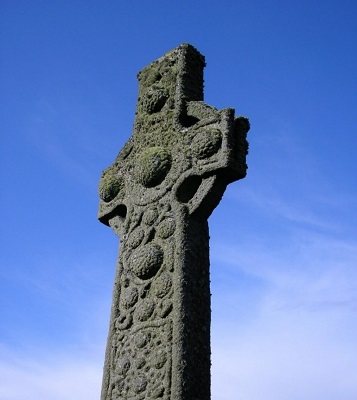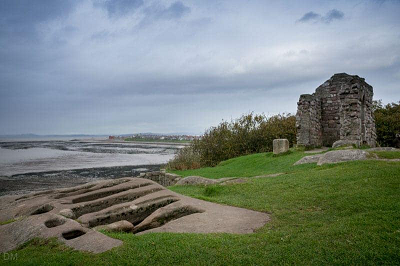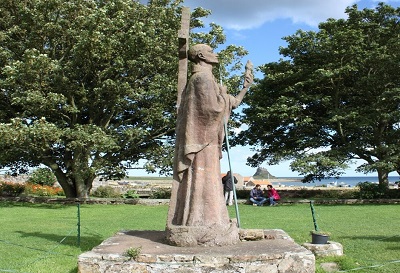Many would regard the mission of Saint Augustine, which began at Canterbury in 597AD when Pope Gregory sent him to ‘make angels of the Angles’, as the beginning of organised Christianity in our country, but in fact Christianity had its roots much earlier on the Celtic fringes of the north and west and was firmly established in Ireland well before Saint Patrick went there as Bishop in 430AD.
In 200AD, Tertullian wrote ‘a bare list of the peoples who believe in Christ’ and added that ‘also places in Britain which, though inaccessible to the Romans, have yielded to Christ’. By the 3rd century, there was a monastic community in Carlisle – we know because in 250AD Bishop Neilor from Carlisle was martyred with Bishop Nicholas of Penrhyn near Glasgow during the reign of Emperor Diocletian.
Emperor Constantine became the first Christian ruler of the Roman world and in 313AD the Edict of Milan legalised Christianity across the whole of the Roman Empire. By 392AD, Emperor Theodosius decreed that Christianity was to be the only legal religion of the Roman Empire. Meanwhile, in Britain, a series of independent Celtic Christian centres were flourishing.
Archaeological evidence has emerged from the area around Hadrian’s Wall, and at Maryport in Cumbria, showing organised Christian activity during this period.
Towards the end of the 4th century, Saint Ninian, a Briton possibly educated at the monastery at Carlisle, had come back from Rome and from Tours in Gaul, and had made Whithorn in Galloway the centre of his missionary work and is known to have extended his activities south into what is now Cumbria. He died in 432AD.
Whithorn became a major teaching centre and developed strong links between Ireland, Scotland, Britain, and Wales, and maintained its links with Europe and beyond.
It has also been suggested that Saint Patrick, who came from the region of Birdoswald near to Hadrian’s Wall, undertook part of his education in a monastery where Saint Ninian taught.
Well before the coming of the Romans, there was a network of sea routes along the Atlantic seaboard of Europe, where trading and community developments thrived; the Eastern, more mystical monasticism flowed from the middle east via the Atlantic to northern Celts of Ireland and western Britain. It has been suggested that the Furness Peninsula was near this network of significant sea routes, and may well have helped to shape Celtic Christianity in the north.
Saint Patrick was consecrated as a bishop in Rome in 432AD and returned to Ireland intending to organise the Church there on diocesan lines, as wanted by the Pope. However, he met significant resistance, but persevered. He came to realise that the physical geography of Ireland, its demographics and its mystical spirituality did not suit such a formal structure, so he embraced monasticism wholeheartedly. It is also believed that he introduced the Celtic Cross as a symbol of God’s love for the whole world.
Finnian, regarded as the ‘father of Irish monasticism’, spent some time at the ‘teaching school’ at Whithorn, then taught Saint Columba who would go on to develop a major monastic community on Iona in the Outer Hebrides during the late 6th century.

Celtic Cross on Iona
It is known and demonstrated through archaeological investigations that, by the end of the 6th century, an important Irish Celtic monastic community had been established at Heysham (Saint Patrick’s chapel) and the monks had begun to evangelise to the south and north along the coastal route of the Roman road and perhaps across Morecambe Bay into Low Furness. This seems to have developed as a very important centre which influenced later developments at Lancaster and the Lune Valley, and perhaps also at Heversham.

St Patrick’s Chapel at Heysham
About this time, the Angles conquered and occupied the territory to the east of Cumbria and founded the powerful kingdom of Northumbria which included the area around Galloway to the north and south as far as the river Ribble. From about 613AD, for the next 70 years, there was a series of struggles between the English of Northumbria and the Britons of Strathclyde. After the death of Aethelfrith in battle, his sons were sent for refuge to Iona where other sons of nobility in Britain and Ireland were sent to be educated. By the end of the 7th century, most of Cumbria was in Anglian hands.
Meanwhile, Edwin the new King of Northumbria, took a Christian wife (Aethelburga) from Kent who brought with her Paulinus, who was an evangelist as well as a pastor. Edwin accepted the Christian faith in 627AD, and was baptised on Easter Day that year in York. Many of the nobility and humbler folk accepted the faith.
Edwin was killed in 633AD, and the consequent ravishing of his kingdom seemed to be a major setback for the Church, but within a year Oswald overcame Caedwalla at Heavenfield and was made King in 635AD. He set about the conversion of his kingdom and being an ‘old boy’ of Iona he turned to them to provide a bishop.
After a false start, Saint Aidan was appointed to the See of Lindisfarne.

Statue of St Aidan on Holy Island (Lindisfarne), where he established his first monastery.
Saint Bede noted that, following the appointment of Aidan, ‘henceforth, many Irishmen arrived day by day in Britain and proclaimed the word of God with great devotion in all the provinces under Oswald’s rule’. He also noted that ‘most of those who came to preach were monks’.
Next ~ And to Heversham